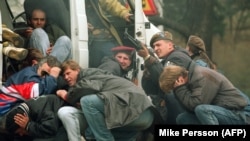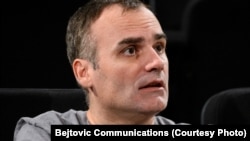Editor's Note: April 5 is the 25th anniversary of the shootings in Sarajevo of two peace demonstrators, the first casualties in what would be a 1,425-day siege of the Bosnian capital by Bosnian Serb forces.
SARAJEVO -- For more than 500 years, the hills surrounding Sarajevo were a place for leisurely strolls, family picnics, and stunning views of the ancient city below.
That all changed a quarter of a century ago with the start of a 44-month siege of the Bosnian capital, where more than 11,500 people* died amid shelling, sniper fire, and a near-total blockade from Bosnian Serbs positioned on the same peaks where children had played just days earlier.
"That was our favorite spot," says Dino Mustafic, a 47-year-old director who lived through the longest siege in the history of modern warfare and still calls Sarajevo his home. "And then suddenly, during the war, it became the symbol of evil and death. Here were the lines of fire from which the city was hit without any obstacles."
WATCH: The Siege That Devastated Sarajevo
While pockmarked buildings scattered around Sarajevo still bear the wounds from almost four years of intense conflict, Bosnia's capital is reemerging physically from the devastation. But its psyche remains a shell of the strong, confident place where many of the world's greatest athletes gathered at the Winter Olympic Games in 1984.
Prior to the siege, which lasted a year longer than the siege of Leningrad by Nazi forces in World War II, Sarajevo was a microcosm of Bosnia: a mix of Orthodox Serbs, Catholic Croats, and Muslim Bosniaks.
But a February 29-March 1 independence referendum highlighted differences between the groups and turned up the heat on simmering tensions that were sweeping across then-Yugoslavia as Belgrade tried to keep the country from tearing apart at the seams.
Bosniaks and Bosnian Croats supported an independent state. Bosnian Serbs, whose strategic goal was to create a new Bosnian Serb state that would include Bosniak-majority areas, didn't and boycotted the vote as their leaders discouraged participation.
The day the referendum ended, an Orthodox wedding in Sarajevo turned to tragedy when a Muslim gunman opened fire in a dispute as the wedding procession, waving Serbian flags, wound its way through the old bazaar area of the city.
Serbian paramilitaries quickly responded by setting up barricades in the center of the city, but the peaceful demonstrations that followed helped defuse the situation.
But across the country, sporadic fighting was breaking out, and when Serb policemen killed two officers and a civilian, a state of emergency was declared and the Serbs rebuilt their barricades.
ALSO READ: Susan Sontag's Lasting Gift To Sarajevans Under Siege
This time, protests were futile and, on April 5, Suada Dilberovic, a Muslim, and Olga Sucic, a Catholic, were shot by gunmen as they crossed the Vrbanja Bridge, which spans the Miljacka River and joined the city's two sides for centuries.
"Those demonstrations were fascinating because they gathered a great number of citizens, tens of thousands, who, unarmed, went out of their homes and said that they didn't want war, that they wanted peace, who wanted to stop all that and believed that they could do it as citizens," Mustafic says.
"They quickly realized after shots were fired from the Holiday Inn hotel as to what our reality was: that the logic of soldiers, of military boots, gunpowder will defeat our desire that there be no war."
Without fresh water, power, or food, Mustafic and tens of thousands of his fellow Sarajevans would endure almost four years of daily fire from heavy artillery and snipers in the once-idyllic nearby hills.
Onetime Bosnian Serb commander Stanislav Galic stood trial for his part in the 1,425-day siege of the city and acknowledged the ferocity of the military action -- the term ethnic cleansing arose from the conflict in Bosnia -- he was directing.
"For a citizen of Sarajevo, there was no place to hide from the attacks. He wasn't safe at home, in schools, or in hospitals," he said during his trial at the International Criminal Tribunal for the former Yugoslavia in The Hague. In December 2003, Galic was sentenced to 20 years in prison by the court.
Though he was on the other side of the gun barrel, filmmaker Nihad Kresevljakovic agrees with Galic's assessment.
He, too, lived through the siege and has stayed in Sarajevo. At times during the onslaught he would look up at the peaks surrounding the city wondering if, and when, the shells would stop raining down.
"The lines of these mountains and hills around Sarajevo were the borders of the universe for us down here," he recalls as he sits on Vrbanja Bridge.
"Somehow, it is like you are observing this painting and after years of siege you start wondering whether there is anything beyond those lines. Really, that sensation of the siege is linked to this image of the horizon and city borders."
In October 1995, the siege was finally lifted by a cease-fire agreement. Two months later, the Dayton peace accords split Bosnia into two highly autonomous regions with power in the country divided along ethnic lines.
Though the fighting has long stopped, tensions still simmer just below the surface. Even a stroll through Sarajevo today evokes mixed feelings.
Amid new buildings, shopping centers, and a constant stream of the newest-model cars zipping through the streets, reminders of the siege are everywhere.
Cemeteries, hit hard by the mortars fired from the hills above, now crop up in the oddest of places: a soccer field, a park, a garden. They show the indiscriminate toll inflicted by 14 months of nearly continuous shelling.
For Mustafic, the memories of his childhood playground in the Trebevic hills high above have yet to overtake the nightmares founded on his experience down in the city during the siege. But he's trying.
"I will strive, because of the generations that will come after us, to tell everything as it was. But also to find in myself the strength to wake up all those memories which will recall in me the sense of beauty and life which I also know, and that is life in peace, in harmony, in unity," he says.
"And I really want Trebevic -- I think it is gradually recovering -- to again become the spot that it was before the war."

















